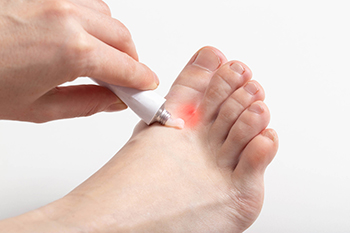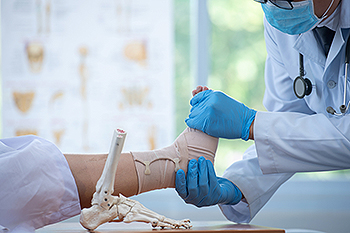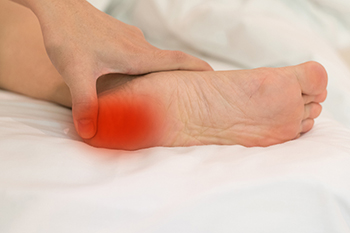Items filtered by date: December 2023
Injury From a Winter Sport? Get the Care You Need
Symptoms of Athlete’s Foot

Athlete’s foot, medically known as tinea pedis, is a common and extremely contagious fungal infection that targets the skin on the feet, particularly the spaces between the toes. Among the primary indicators of athlete’s foot is persistent itching and burning sensations experienced between the toes and on the soles of the feet. The discomfort caused by this incessant itching can significantly impact daily activities, leading individuals to find relief through constant scratching or rubbing, which may serve to spread the infection. Redness and inflammation in the affected areas are also signs of athlete's foot. Prolonged exposure to moisture or heat, such as wearing sweaty shoes or walking barefoot in communal areas like public showers or pool areas, tends to exacerbate these symptoms. Peeling and cracking of the skin, especially in areas prone to excessive sweating or friction, are common occurrences in athlete’s foot. The skin may take on a dry, flaky appearance, resembling sunburn or dry skin, making diagnosis challenging without proper knowledge. In certain cases, athlete’s foot may result in blister formation, particularly when excess moisture is trapped within shoes or socks. Unlike blisters from other conditions, those caused by athlete's foot are typically smaller and may contain clear fluid or pus. It is vital not to pop these blisters, as doing so can increase the risk of infection. For help in managing the effects of athlete’s foot, it is suggested that you make an appointment with a podiatrist.
Athlete’s foot is an inconvenient condition that can be easily reduced with the proper treatment. If you have any concerns about your feet and ankles, contact Cecilia Capuano-King, DPM from New York. Our doctor will treat your foot and ankle needs.
Athlete’s Foot: The Sole Story
Athlete's foot, also known as tinea pedis, can be an extremely contagious foot infection. It is commonly contracted in public changing areas and bathrooms, dormitory style living quarters, around locker rooms and public swimming pools, or anywhere your feet often come into contact with other people.
Solutions to Combat Athlete’s Foot
- Hydrate your feet by using lotion
- Exfoliate
- Buff off nails
- Use of anti-fungal products
- Examine your feet and visit your doctor if any suspicious blisters or cuts develop
Athlete’s foot can cause many irritating symptoms such as dry and flaking skin, itching, and redness. Some more severe symptoms can include bleeding and cracked skin, intense itching and burning, and even pain when walking. In the worst cases, Athlete’s foot can cause blistering as well. Speak to your podiatrist for a better understanding of the different causes of Athlete’s foot, as well as help in determining which treatment options are best for you.
If you have any questions please feel free to contact our office located in Smithtown, NY . We offer the newest diagnostic and treatment technologies for all your foot and ankle needs.
Managing Infected Ingrown Toenails

Ingrown toenails, a common problem causing pain and inconvenience, can affect anyone. However, they are most frequently seen in young adults and adolescents. These toenails usually affect the big toe but can affect other toes as well. Causes of ingrown toenails include direct trauma to the toe, genetic predisposition, improper nail trimming, and wearing poorly fitting shoes. There are three stages of ingrown toenails. Stage one involves redness, slight swelling, and pain at the lateral nail fold. Stage two presents with increased pain, discharge from the nail edge, and signs of bacterial paronychia. In stage three, hypertrophic granulation tissue forms on the lateral wall. Treatment ranges from the conservative to surgery. If you have an ingrown toenail, particularly if it appears infected, it is suggested that you schedule an appointment with a podiatrist to have the affected nail evaluated, and proper treatment given.
Ingrown toenails can become painful if they are not treated properly. For more information about ingrown toenails, contact Cecilia Capuano-King, DPM of New York. Our doctor can provide the care you need to keep you pain-free and on your feet.
Ingrown Toenails
Ingrown toenails occur when a toenail grows sideways into the bed of the nail, causing pain, swelling, and possibly infection.
Causes
- Bacterial infections
- Improper nail cutting such as cutting it too short or not straight across
- Trauma to the toe, such as stubbing, which causes the nail to grow back irregularly
- Ill-fitting shoes that bunch the toes too close together
- Genetic predisposition
Prevention
Because ingrown toenails are not something found outside of shoe-wearing cultures, going barefoot as often as possible will decrease the likeliness of developing ingrown toenails. Wearing proper fitting shoes and using proper cutting techniques will also help decrease your risk of developing ingrown toenails.
Treatment
Ingrown toenails are a very treatable foot condition. In minor cases, soaking the affected area in salt or antibacterial soaps will not only help with the ingrown nail itself, but also help prevent any infections from occurring. In more severe cases, surgery is an option. In either case, speaking to your podiatrist about this condition will help you get a better understanding of specific treatment options that are right for you.
If you have any questions please feel free to contact our office located in Smithtown, NY . We offer the newest diagnostic and treatment technologies for all your foot and ankle needs.
Causes and Signs of a Broken Ankle

A broken ankle, a distressing injury, occurs when one or more of the bones comprising the ankle joint suffer a fracture. This injury is often the result of sudden trauma, such as a fall, a twisting motion, or a direct impact, causing the bones to exceed their structural limits. The severity of a broken ankle can vary, ranging from simple fractures to more complex fractures that involve multiple bones. Recognizing the signs is essential for prompt intervention. Common indicators can include intense pain, swelling, and bruising around the ankle. Individuals may find it challenging to bear weight on the affected foot, and there could be noticeable deformities or misalignment. Seeking immediate medical attention from a podiatrist is imperative for an accurate diagnosis. If you have broken your ankle, it is suggested that you visit this type of healthcare professional as quickly as possible who can provide you with correct treatment methods.
Broken ankles need immediate treatment. If you are seeking treatment, contact Cecilia Capuano-King, DPM from New York. Our doctor can provide the care you need to keep you pain-free and on your feet.
Broken Ankles
A broken ankle is experienced when a person fractures their tibia or fibula in the lower leg and ankle area. Both of these bones are attached at the bottom of the leg and combine to form what we know to be our ankle.
When a physician is referring to a break of the ankle, he or she is usually referring to a break in the area where the tibia and fibula are joined to create our ankle joint. Ankles are more prone to fractures because the ankle is an area that suffers a lot of pressure and stress. There are some obvious signs when a person experiences a fractured ankle, and the following symptoms may be present.
Symptoms of a Fractured Ankle
- Excessive pain when the area is touched or when any pressure is placed on the ankle
- Swelling around the area
- Bruising of the area
- Area appears to be deformed
If you suspect an ankle fracture, it is recommended to seek treatment as soon as possible. The sooner you have your podiatrist diagnose the fracture, the quicker you’ll be on the way towards recovery.
If you have any questions, please feel free to contact our office located in Smithtown, NY . We offer the newest diagnostic and treatment technologies for all your foot care needs.
Parental Guidance for Children Who Have Sever’s Disease

Parental guidance is vital for families with children experiencing Sever's Disease, a common condition affecting the heels of children during growth spurts. First and foremost, it is essential to educate yourself and your child about what Sever's Disease is, and what causes it. By providing age-appropriate information, you can reduce any anxiety your child may have about the condition. One important aspect of managing Sever's Disease is ensuring that your child wears comfortable, supportive shoes with proper arch support. Avoiding flat or poorly cushioned footwear may help to alleviate discomfort. Encourage your child to take breaks and rest, especially during strenuous activities involving running or jumping. Performing gentle calf and Achilles tendon stretches can also promote flexibility and reduce tightness. Support your child with the knowledge that symptoms are likely temporary and resolve when the heel’s growth plate matures. If your child is experiencing heel pain, it is suggested that you make an appointment with a podiatrist who can provide a proper diagnosis and treatment plan.
Sever's disease often occurs in children and teens. If your child is experiencing foot or ankle pain, see Cecilia Capuano-King, DPM from New York. Our doctor can treat your child’s foot and ankle needs.
Sever’s Disease
Sever’s disease is also known as calcaneal apophysitis, which is a medical condition that causes heel pain I none or both feet. The disease is known to affect children between the ages of 8 and 14.
Sever’s disease occurs when part of the child’s heel known as the growth plate (calcaneal epiphysis) is attached to the Achilles tendon. This area can suffer injury when the muscles and tendons of the growing foot do not keep pace with bone growth. Therefore, the constant pain which one experiences at the back of the heel will make the child unable to put any weight on the heel. The child is then forced to walk on their toes.
Symptoms
Acute pain – Pain associated with Sever’s disease is usually felt in the heel when the child engages in physical activity such as walking, jumping and or running.
Highly active – Children who are very active are among the most susceptible in experiencing Sever’s disease, because of the stress and tension placed on their feet.
If you have any questions, please feel free to contact our office located in Smithtown, NY . We offer the newest diagnostic and treatment technologies for all your foot and ankle injuries.

